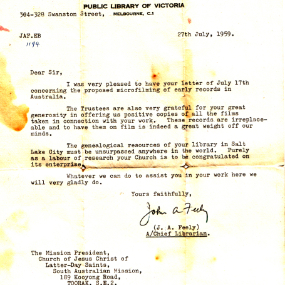Employed by the Genealogical Society of Utah (GSU) on 2 April 1959 as the first camera operator in Australia, Ron Pollard began the first microfilming project for the Pacific.
.jpg)
Ron
Ron Pollard in 1959 when he began preserving Australian records through microfilm© 2024 by Intellectual Reserve, Inc. All rights reserved.Now known as FamilySearch International and one of the largest genealogical organisations in the world, the GSU was formed in 1894 to help members of The Church of Jesus Christ of Latter-day Saints trace their family trees.
In 1938 FamilySearch pioneered the use of microfilm as a record preservation tool and over the years has collected, preserved, and shared 5.5 billion records worldwide. Microfilm was used until 2002 when capture became 100 percent digital.

Ron
1959 letter from Public Library of Victoria to South Australian Mission President, John O. Simonsen© 2024 by Intellectual Reserve, Inc. All rights reserved.On 20 April 1959, in a small room with his camera set up in what is now the State Library of Victoria in Melbourne, Ron began microfilming Assisted Shipping Records into Victoria, held by the Public Records Office Victoria (PROV).
In the 1950’s, PROV shared facilities with the State Library of Victoria (SLV) located in Swanston Street, Melbourne. The original paper documents were folded and tied with red tape. They had not been stored in Archival conditions, so they were very dirty and in poor condition.
Ron employed five university students during the term breaks to assist in document preparation. Their job was to unfold, clean, and repair the damaged pages before they were microfilmed.
At the time, all negotiations to access records were done through the Church’s Melbourne mission president, John O. Simonsen (late 1950s), followed by Bruce R. McConkie (early 60s).
In 1998, the GSU began digital imaging of records and in May 1999, the first FamilySearch website opened to the public with great interest.
After extended negotiations, in November 2004 FamilySearch began digitising records held by Public Records Office Victoria (PROV) at the Victorian Archives Centre (VAC) North Melbourne.
The initial project was the Wills & Probate Files from 1844-1925. The Lombardi’s, a retired couple from the US were the first camera team and they were soon joined by a senior missionary couple from Canada to operate the second digital camera.
| Temple Square is always beautiful in the springtime. Gardeners work to prepare the ground for General Conference. © 2012 Intellectual Reserve, Inc. All rights reserved. | 1 / 2 |
To speed the process, local Church members were recruited as volunteers to assist in document preparation. They have since done the Inquest Deposition Files and Wills & Probates 1926-1950.
To enable easy access, a community indexing project was co-ordinated by Lesle Berry on behalf of the Victorian Association of Family History Organisations (VAFHO) with resources provided by FamilySearch.
Wills & Probates are a valuable resource for family history researchers. Prior to digitising and indexing these files, the only way to view them was through a visit to the Victorian Archives Centre in North Melbourne.
The files needed to be ordered with waiting times, then if copies were needed, these had to be ordered and paid for before they were posted out several weeks later. Now the files can be viewed and printed out without any delays from the FamilySearch and PROV websites.
The Church of Jesus Christ of Latter-day Saints offers FamilySearch services free of charge to everyone to help millions of people around the world discover their heritage and connect with their family members.
Through their website, mobile apps, and in person at over 5000 family history centres, FamilySearch collaborates with more than 10,000 archives and organisations in more than 100 countries to help people grow stronger through their family relationships—past, present, and future.
For more information, see:
Your Family Tree, Archives, and Genealogy • FamilySearch
Family History Research in Australia and New Zealand, Australia • FamilySearch